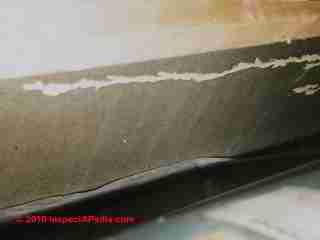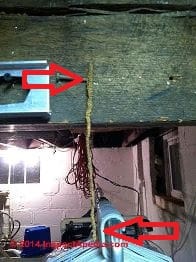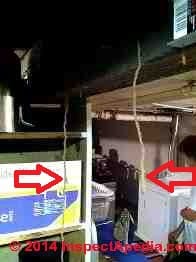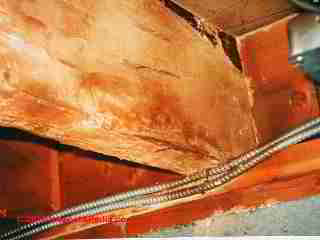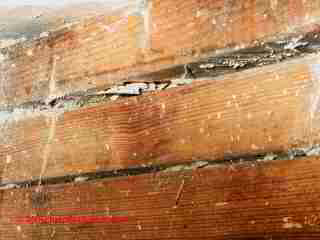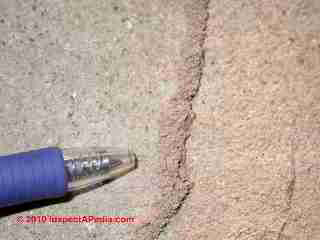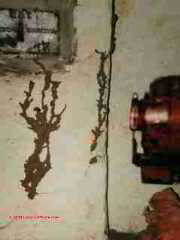 Termite Mud Tubes
Termite Mud Tubes
How to recognize termite damage, termite mud tubes & what they mean when found in or on buildings or other structures
- POST a QUESTION or COMMENT about termite damage assessment methods
Termite mud tubes & passages:
What is a termite mud tube and how are they recognized? What do termite mud tubes tell us about the age, location, and extent of termite activity or wood destroying termite damage in or on a building or on other wood structures. Where are termite mud tubes found? What happens if we disturb a termite mud tube? Are outdoor termite mud tubes a concern?
This article series provides a case study of a termite inspection that found insect & rot damage:photographs, inspection advice & visual clues that led to discovery of severe hidden structural damage to a building.
InspectAPedia tolerates no conflicts of interest. We have no relationship with advertisers, products, or services discussed at this website.
- Daniel Friedman, Publisher/Editor/Author - See WHO ARE WE?
Termite Mud Tubes - Important Indicators of Termite Damage
Termite Damage Mud Tubes Photographs Suggest Where to Look
Our termite damage photograph just above illustrates that carpenter ant activity (frass or loose "sawdust) may be found in the same location as termite activity (the mud tubes).
Our second termite mud tube photo (below) is more clear and shows branching termite mud tubes running along the surface of a floor joist.
Watch out: termites prefer to tunnel inside of wood and can cause extensive damage without appearing readily on the wood surface.
Mud tubes are typically built to enable movement across a less hospitable surface such as masonry walls or wood that was just not so nice to penetrate.
Termites had traveled extensively in the ceiling joist shown in our photo at below-left. The sill plates located on the floor in this same room were also infested (photo below right).
Hanging Termite Mud Tubes - Termite Stalactites
Reader Question: We noticed some hard stalagmite looking things (pictures attached) in our basement and we were wondering if these are from termites? - G.M. 8/3/2014
[Click to enlarge any image]
Reply: I'm sorry to say yes, that looks like significant and active termite activity. The hanging mud tubes are the critters' exploration for another wood contact avenue besides the beam that they already infest.
Because those hanging mud tubes are quite fragile I infer from your photographs that either they are located in an area where no one has passed for some time or the termite activity is voracious.
Steps to Address Hanging Termite Mud Tubes
1. Call a pest control company to inspect for the location and extent of activity and to treat the termite activity.
Also see STRUCTURAL DAMAGE PROBING
2. Determine the extent of structural damage and thus what repairs are needed.
See the FEAR-O-METER: Dan's 3 D's SET REPAIR PRIORITIES a promotion theory to convert risk of hidden defects & hazards into action thresholds, for a discussion of how an accumulation of inspection evidence leads to a rational decision to perform invasive or destructive inspection measures such as removing siding or cutting into walls or floors where hidden termite damage may be most likely.
3. Determine building or site factors that increase the risk of termite activity and correct those, such as wood-soil contact, building leaks, splash-up of roof drainage against building walls, wet basements.
See TERMITE INVITING CONSTRUCTION
Also see WATER ENTRY in BUILDINGS
Termite Mud Tubes on Foundation Walls
Below our termite mud tube photos illustrate how extensive branching mud tubes may be found on building foundation walls headed for wood framing members and even along metal pipes.
Below: it appears that termites entered through a crack in the foundation wall, then built mud tubes upwards looking for a more hospitable wood material.
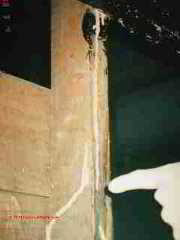
Termite Mud Tubes at Wood Framing Intersections & in Wood Beam Checking Splits
Below our termite mud tube photos illustrate the importance of a careful, expert termite inspection. The mud tubes at below left are close to and tightly located against the junction of subfloor and rim joist, and the butt end of a floor joist and rim joist and are not as easy to spot as our earlier termite photographs.
And BELOW we demonstrate that termites might run along the interior of an old wooden beam; we found these termite tunnels by probing inside the large open checking or splits that would normally be considered not a structural concern, but adding termite damage can change that evaluation.
See SPLITS & CRACKS in STRUCTURAL WOOD BEAMS for more about log and beam checking or splitting.
Below we illustrate additional termite mud tubes running horizontally inside the checking of an older wood floor beam in the same building that sported the termite stalactites illustrated above.
Photo Guide to Termites & Termite Mud Tubes Outdoors
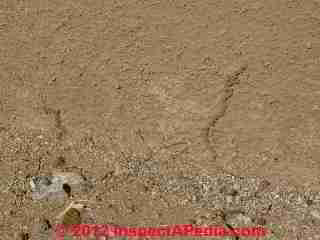
Termite mud tubes may appear on the outside (photo at left) or inside of building walls or other structural components (photo at left) or they may appear on the ground itself (below left).
These Arizona termite mud tube photos just below were contributed by our Arizona correspondent (and daughter) Mara Gieseke, Tucson AZ who reports:
So what do you think of these Arizona Desert Termites
... I went out back today to try and get some pictures for you.
I got one photo of the termite mud tubes that are on a masonry retaining wall that is quite a distance from our house.
Then I swiped my shoe over the mud trails (below left) that I saw in the dirt, but there were no termites in any of them.
Where did they go?
The other time I kicked open a termite mud tube there were at least 50 Arizona termites squirming in the mud (below right).
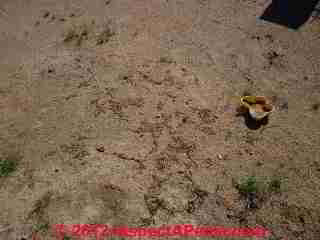
[Mara Gieseke's termite photo (above right) shows Arizona termites squirming in the sunlight just after she disturbed their ground-surface mud tube.
We have enlarged this photo to make the termites easier to see, but notice how difficult it is to spot them against the sandy soil found in the Tucson area. How big are termites in actual life-size?
If you could get these termites to line up in single file and march across a U.S. dime, you'd see that if they marched along the diameter of the dime there would be at least five of them. Typical termites are 5.5 mm in length but vary in size from about 1/8" long to as much as 3/8" for the big boys.
Queen termites are bigger, over 3/4" in length excluding a pregnant queen's abdomen that, if included can make her total size 2" or even more.
There are about 2800 termite species that have been identified, grouped in seven families (including the largest family, Termitidae), and it is probable that there are other species not yet classified.]
The retaining wall is 20 feet from the house, and we found tubes growing vertically in the grass too. I also got a picture of a section of dirt that has lots of those mud trails.
We've have never had termite activity inside the house. The first year that we lived here we had to have the pest control people out here several times to treat the expansion joint where the back patio meets the house.
What Happens if We Disturb or Break Open Termite Mud Tubes
Disturbing a termite mud tube is shown just below. They won't bite you, but some genera/species of termites will indeed bite a wood structure or its wood siding or trim.
If you disturb a mud tube and termites fall out you know for sure you've found an active colony. Unfortunately the converse is not necessarily true.
If you disturb a mud tube and don't see any termites, you'll need more information and probably a more expert inspection before you know if there is ongoing termite activity or not.
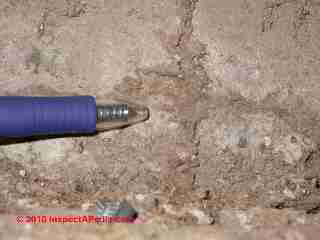
...
Continue reading at TERMITE SHIELDS vs TERMITICIDE or select a topic from the closely-related articles below, or see the complete ARTICLE INDEX.
Or see these
Recommended Articles
- MERULIPORIA FUNGUS & TERMITE INTERACTIONS
- PORIA DAMAGE PREVENTION
- ROT, FUNGUS, TERMITES
- TERMITE DAMAGE INSPECTION
- TERMITE IDENTIFICATION & CONTROL
- TERMITES & NAPTHALENE HAZARDS
- TERMITE SHIELDS vs TERMITICIDE
Suggested citation for this web page
TERMITE MUD TUBES at InspectApedia.com - online encyclopedia of building & environmental inspection, testing, diagnosis, repair, & problem prevention advice.
Or see this
INDEX to RELATED ARTICLES: ARTICLE INDEX to INSECT DAMAGE
Or use the SEARCH BOX found below to Ask a Question or Search InspectApedia
Ask a Question or Search InspectApedia
Try the search box just below, or if you prefer, post a question or comment in the Comments box below and we will respond promptly.
Search the InspectApedia website
Note: appearance of your Comment below may be delayed: if your comment contains an image, photograph, web link, or text that looks to the software as if it might be a web link, your posting will appear after it has been approved by a moderator. Apologies for the delay.
Only one image can be added per comment but you can post as many comments, and therefore images, as you like.
You will not receive a notification when a response to your question has been posted.
Please bookmark this page to make it easy for you to check back for our response.
IF above you see "Comment Form is loading comments..." then COMMENT BOX - countable.ca / bawkbox.com IS NOT WORKING.
In any case you are welcome to send an email directly to us at InspectApedia.com at editor@inspectApedia.com
We'll reply to you directly. Please help us help you by noting, in your email, the URL of the InspectApedia page where you wanted to comment.
Citations & References
In addition to any citations in the article above, a full list is available on request.
- Best Practices Guide to Residential Construction, by Steven Bliss. John Wiley & Sons, 2006. ISBN-10: 0471648361, ISBN-13: 978-0471648369, Hardcover: 320 pages, available from Amazon.com and also Wiley.com. See our book review of this publication.
- David Grudzinski, Advantage Home Inspections, ASHI cert # 249089, HUD cert# H-145, is a professional home inspector who contributes on various topics including structural matters. Mr. Grudzinski, Cranston RI serving both Rhode Island and Eastern Connecticut can be reached at 401-935-6547 fax- 401-490-0607 or by email to Davidgrudzinski@aol.com. Mr. Grudzinski is a regular contributor to InspectAPedia.com - see DECK FLASHING LEAKS, ROT Case Study, and BASEMENT WATER MOLD IMPACT and VERMICULITE INSULATION for examples.
- Mara and Andy Gieseke, Tucson AZ, are contributors to InspectAPedia.com including photographs used at SIDING EIFS & STUCCO, CONTROL JOINT CRACKS in CONCRETE and ROT, FUNGUS, TERMITES, and are family members of website publisher Daniel Friedman.
- Desert Termites, Thomas W. Fuchs, Extension Entomologist, Darrell N. Ueckert, Texas Agricultural Experiment Station, and Bastiaan M. Drees, Extension Entomologist, Texas Agricultural Extension Service, Texas A&M University System, web search 09/13/2010, original source: http://insects.tamu.edu/extension/bulletins/uc/uc-016.html
- Termites - Greenhouse Gases, U.S. EPA, Environmental Protection Agency. Web search 09/11/2010, original source: http://www.epa.gov/ttn/chief/ap42/ch14/final/c14s02.pdf Quoting an interesting passage from this brief document:
Termites inhabit many different ecological regions, but they are concentrated primarily in tropical grasslands and forests. Symbiotic micro-organisms in the digestive tracts of termites (flagellate protozoa in lower termites and bacteria in higher termites) produce methane (CH4). Estimates of the contribution to the global budget of CH4 from termites vary widely, from negligible up to 15 percent. - Truly Nolen Pest Control, Tel: 866-221-4765, is a national franchise of pest control operators in the U.S. Quoting from the company's website:
Truly Nolen [has] over 80 offices located in Arizona, California, Florida, Nevada, New Mexico, Texas and Utah. The company services more than 150,000 customers and employs about 1,100 partners, with almost 50 percent service technicians. Domestic franchises are offered throughout the United States. International franchises are also established in over 30 countries. - U.S. EPA. Prevention, Pesticides, and Toxic Substances. 1997. Re registration eligibility decision: Diflubenzuron. Pp. 17, 46. www.epa.gov/ pesticides.
- U.S. EPA. Office of Prevention, Pesticides and Toxic Substances. 1994. Pesticide fact sheet: Hexaflumuron. Washington, D.C.
- U.S. EPA. Office of Pesticide Programs. 2003.
Pesticide ecotoxicity database. Unpublished database.
U.S. EPA. Prevention, Pesticides, and Toxic Substances. 1998. Re registration eligibility decision: Hydramethylnon. Pp. 16-18, 43. www.epa.gov/pesticides. - U.S. EPA. Prevention, Pesticides and Toxic Substances. Undated. New chemical New chemical fact sheet: Noviflumuron. Washington, D.C.
- "Protecting Your Home from Subterranean Termite Damage", Journal of Pesticide Reform, Fall 2004, V 24 No. 3, - 6-7, Northwest Coalition for Alternatives to Pesticides/NCAP, POB 1393, Eugene OR, 97440 541-344-5044 www.pesticide.org: Web search 09/11/2010: http://www.hipspro.com/pubs/subterraneantermites.pdf
This document discusses alternatives for termite protection including reducing the attractiveness of the structure to termites (get wood away from the building, fix leaks), use of 16-grit sand (diameter 0.06 - 0.1 in) as a termite barrier 18" wide x 3" deep in crawl areas, or stainless steel mesh for the same purpose under foundations and slabs, boric acid, Diflubenzuron (insect growth regulator, risk genetic damage, EPA classed as carcinogen), Hexaflumuron (insect growth regulator, EPA didn't ID health concerns, waived some testing, partly because of anticipated very low risk of human exposure), Hydramethylnon (stomach toxicant, EPA: Carcinogen, highly toxic to fish), Noviflumuron (chemically similar to hexaflumuron), can cause anemia, EPA didn't ID other health hazards, some testing requirements waived, moderately toxic to fish).
Articles about Rot, fungus, Termites, Carpenter Ants, Powder Post Beetles, Leaks and Water Entry Damage in Buildings
- Basement water entry: what the basement waterproofing companies don't tell you? Water entry prevention and repair suggestions. -- in process
- Building floods how to respond to avoid mold
- Desert Termites, Thomas W. Fuchs, Extension Entomologist, Darrell N. Ueckert, Texas Agricultural Experiment Station, and Bastiaan M. Drees, Extension Entomologist, Texas Agricultural Extension Service, Texas A&M University System, web search 09/13/2010, original source: http://insects.tamu.edu/extension/bulletins/uc/uc-016.html
- Floods in Buildings & interior water damage cleanup, prevention, testing quick steps to prevent mold contamination
- Home Inspectors Directory accessible via Internet - a home inspection can point out maintenance details that are key in avoiding leaks, rot, mold, insect damage
- "House Eating Fungus"Meruliporia incrassata (also called "Poria" the house eating fungus) in the U.S. or Serpula lacrymans in Europe) can cause severe structural damage. Evidence of hidden "poria" may be found by expert inspection methods which include tracing sources and paths of probable Building leaks and moisture traps. Further, careful indoor particle sampling methods can often permit the presence of this mold to be identified in the laboratory.
- HUMIDITY CONTROL & TARGETS INDOORS How Low Should You Keep Indoor Humidity to Avoid a Mold Problem
- Ice Dam Leak Prevention by Proper Insulation, and Ventilation [Carson Dunlop] - also see ATTIC CONDENSATION CAUSE & CURE.
- ICYNENE FOAM SPRAY INSULATION - resistance to mold growth and resistance to insects
- Insects & Foam Insulation - guide to insect damage related to foam building insulation products
- INSULATION LOCATION for BASEMENTS & CRAWLSPACES - where to place building insulation in basements and crawl spaces
- Insulation & ventilation issues
- Interiors: Attic condensation, basement water entry dampness, toxic mold inspection, testing, Moisture, Mold, Mildew, mold remediation advice,
- Mobile Home Inspections common defects unique to factory built housing, inspection methods
- Mold Resistant Drywall is mold-resistant or "mold proof" SheetrockR from US Gypsum or Georgia Pacific worth it?
- Mold Prevention: Avoiding Mold Problems in Buildings by Using Mold-resistant Construction Products & Practices
- Mold Information Center: What to Do About Mold, mold action plan, valid and invalid test methods, mold remediation
- Pesticides Contaminate House [PDF] - news article about improperly applied pesticide chemicals and building contamination
- Sick House/Sick Building Information Website Organized, un-biased, in-depth advice about mold, allergens, and other indoor contaminants: finding, testing, cleaning, clearance testing, and preventing mold, mildew, wood destroying (rot) molds (fungi). Explains how to assure that testing for toxic or allergenic molds is performed using valid field and lab methods. Advice and test procedures are provided for odors and odor source detection, toxic gas testing and gas source identification.
- TERMITE SHIELDS vs TERMITICIDE - Use of Termiticide (termite poison) vs. Termite Shields on Styrofoam™ board insulated buildings
- Termite Damage in Buildings: causes, detection, prevention for hard-to-inspect properties - [in process], this article explains how visual clues both outside and inside a building can predict the most-likely points of insect attack (or leaks, water entry, mold, rot). That tells the inspector or home owner where to look first for trouble as well as how to avoid structural damage from insects, rot, mold, or water.
- Termite Damage Case Study#1 - exterior clues predicted insect damage; interior access was limited but certain clear clues led right to the damage as well as an attempted cover-up of termite damage below a "repaired" wooden floor. The real evidence was in the driveway. [in process]
- Termite Damage Case Study#2 - very limited visual access inside a building made this inspection for structural damage tough. Outside conditions suggested a risk of water entry and insect attack. Inside the house had mysteriously sloping floors - sloping in every direction. There were few indications of ongoing building movement to explain the sloping. Perseverance led to finding severe termite damage at the building sills. [in process]
- Termites, Wikipedia web search 09/11/2010, original source: http://en.wikipedia.org/wiki/Termite provided some information about termite size.
- In addition to citations & references found in this article, see the research citations given at the end of the related articles found at our suggested
CONTINUE READING or RECOMMENDED ARTICLES.
- Carson, Dunlop & Associates Ltd., 120 Carlton Street Suite 407, Toronto ON M5A 4K2. Tel: (416) 964-9415 1-800-268-7070 Email: info@carsondunlop.com. Alan Carson is a past president of ASHI, the American Society of Home Inspectors.
Thanks to Alan Carson and Bob Dunlop, for permission for InspectAPedia to use text excerpts from The HOME REFERENCE BOOK - the Encyclopedia of Homes and to use illustrations from The ILLUSTRATED HOME .
Carson Dunlop Associates provides extensive home inspection education and report writing material. In gratitude we provide links to tsome Carson Dunlop Associates products and services.



